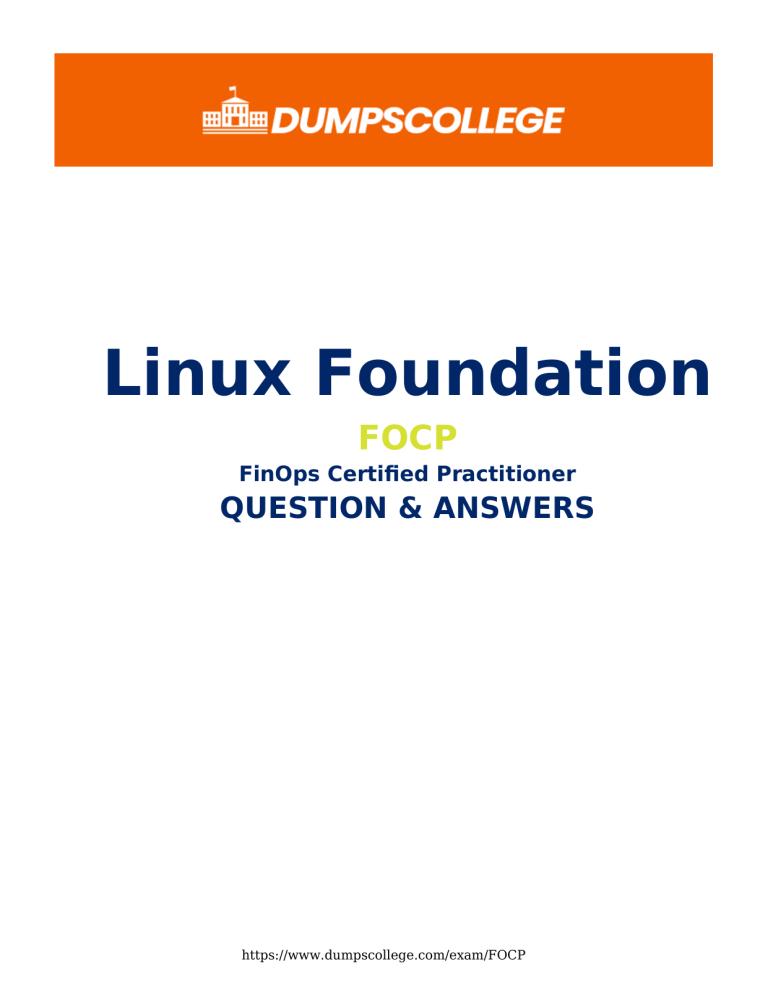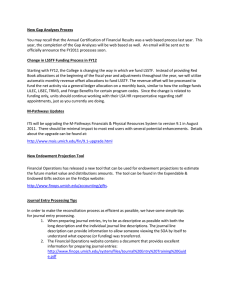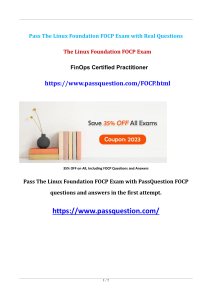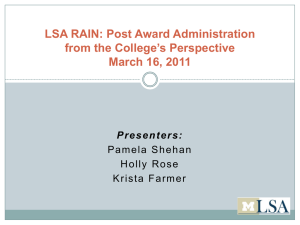FOCP Exam Questions & Answers: FinOps Certified Practitioner
advertisement

Linux Foundation FOCP FinOps Certified Practitioner QUESTION & ANSWERS https://www.dumpscollege.com/exam/FOCP QUESTION 1 Distributed decision making coupled with the move to variable spending in cloud allows technology teams to efficiently partner with finance and business teams to make informed decisions that drive continual optimization. (True or False) A. False B. True Correct Answer: B Explanation/Reference: Statement is correct. Remember that FinOps is really about collaboration. Please review the following page FinOps What is? QUESTION 2 Your currently adopting FinOps in your organization and are in Stage 1 - Planning for FinOps in an organization. Which of the following two exercises would be understand Stage 1? (Select Two) A. B. C. D. Create a Plan Practice Formation Do Your Research Build a Toolbox Correct Answer: A,C Explanation/Reference: Explanation: The FinOps Foundation a clear "Adopting FinOps" Slide deck that we must review if we have not purchased the FInOps book. Please find the Slide Deck here QUESTION 3 In a FinOps based organization spending is a concern only for finance team and the FinOps team members. (True or False) A. False B. True https://www.dumpscollege.com/exam/FOCP Correct Answer: A Explanation/Reference: Explanation: Spending is a concern for everyone, whether the finance team, engineering, production, etc. Please review What is FinOps QUESTION 4 What term would we use to define the act of changing the size of provisioned resources to one that better matches needs? (Select One) A. B. C. D. Cost Reduction Cost Avoidance Provisioning Right-Sizing Correct Answer: D Explanation/Reference: Explanation: When a cloud resource is provisioned larger than is required, such as having too much memory or compute power, it’s considered oversized. Rightsizing is the act of changing the size of provisioned resources to one that better matches needs. QUESTION 5 Each of the major cloud providers provides its services in geographic Regions made up of multiple subunits called: A. B. C. D. Zones, or Availability Zones Instances, or VMs Resource Groups or VPCs Date Centers or Availability Regions Correct Answer: A https://www.dumpscollege.com/exam/FOCP QUESTION 6 Which of the following would be the correct description of what a 'cluster" is in Kubernetes? (Select One) A. B. C. D. An instance of a container image A template of a container with the software that needs to be run. A template of services to be ran in Kubernetes A group of server instances, managed by container orchestration. Correct Answer: D Explanation/Reference: Explanation: There are a number of terms for Kubernetes that we need to be aware for the exam. It can be challenging at first to confuse a cluster, pod, service, image, namespace, etc. Please review the table here Container Costs QUESTION 7 Which of the following would be considered a "measure of success" for a FinOps based organization? (Select Two) A. B. C. D. Overall Tagging Compliance is 90% or above The cloud cost reporting ecosystem becomes a fundamental aspect of the IT department Overall Tagging Compliance is 70% or above FinOps team can define desired level of training requirements Correct Answer: A,B Explanation/Reference: Explanation: The FinOps Foundation provides some insight into what is considered a measure of success. Measure(s) of Success Overall Tagging Compliance is 90% or above The cloud cost reporting ecosystem becomes a fundamental aspect of the IT department Most product teams are publishing information related to their unit economics FinOps team can define desired level of commitment coverage vs. utilizatio Please review this page before the exam. Success Measures https://www.dumpscollege.com/exam/FOCP QUESTION 8 Each major cloud provider labels the platforms "allocation metadata" a specific way. How does GCP name the allocation metadata? (Select One) A. "Labels” and “billing accounts” B. “Subscriptions”, “resource groups” and “resource tags” C. “Resource tags”, “Linked Accounts” and “groups” D. “Resource tags”, “Linked Accounts” and “Organizations” Correct Answer: A Explanation/Reference: Explanation: GCP uses “labels” and “billing accounts”; AWS “resource tags”, “Linked Accounts” and “Organizations”; Azure “Subscriptions”, “Resource Groups” and “resource tags” We do need to know some cloud provider specific terms for the exam. Refer here before the exam FinOps Terminology QUESTION 9 Which of the following would be correct when comparing TBM to FinOps? (Select Three) A. FinOps has great controls into cloud, granularity, and prescriptive methods but does not include decision data. B. FinOps looks to the fully-burdened all-up view of IT spend whereas TBM looks at hourly costing and identifies infrastructure anomalies in real-time C. TBM takes a top-down view whereas FinOps takes a more bottoms up view. D. FinOps takes a top-down view whereas TBM takes a more bottoms up view. E. FinOps and TBM are not complementary so its a best practice to choose one or the other F. FinOps focuses on cloud processes, cloud data, and cloud execution whereas TBM provides the general ledger (GL) data (labor costs, licensing, revenue data). Correct Answer: A,C,F Explanation/Reference: Explanation: TBM is a value management framework for decision making by CIOs, CTOs, CFO, and the team. Technology Business Management defines the tools, processes, data, and people needed to manage the business of technology.(Looks at all IT Investments and is a top down model) FinOps is the practice of bringing financial accountability to the variable spend model of cloud, enabling distributed teams to make business trade-offs between speed, cost, and quality.(Cloud Only and is https://www.dumpscollege.com/exam/FOCP bottom up model) TBM = Broad Focused while FinOps = Very Focused QUESTION 10 When do you reach the end of the FinOps lifecycle? A. B. C. D. Never, it's a continuous process Once you've achieved the "Run" level In each function When you've eliminated all waste Once you have migrated all of your workloads to the cloud Correct Answer: C QUESTION 11 FinOps Principles are north stars that guide the activities of our FinOps practice. They’re developed by FinOps Foundation members, and honed through experience. When it comes to the FinOps principle of "A centralized team drives FinOps" which of the following statements would be true? (Select Two) A. Never use granular allocation of all costs, direct or shared, to the teams and cost centers responsible for them B. Centralized discount buying process removes rate negotiations from engineering team consideration C. Track team-level targets to drive accountability D. Centrally govern and control Committed Use Discounts, Reserved Instances, and Volume/Custom Discounts with Cloud Providers Correct Answer: B,D Explanation/Reference: Explanation: Using a granular approach is recommended and Track team-level targets to drive accountability is not under the A centralized team section, it is under "Everyone takes ownership for their cloud usage" Please review this page before the exam. https://www.finops.org/framework/principles/ QUESTION 12 Which of these is not a function of Understanding Fully Loaded Costs? A. B. C. D. Map spending data to the business Dynamically calculate custom rates and amortization metrics Identify anomalous spending Set tag/label strategy and compliance https://www.dumpscollege.com/exam/FOCP E. Create showback and/or chargeback reporting Correct Answer: B QUESTION 13 An Availability Zone in AWS is defined as? (Select One) A. B. C. D. A sub-unit of an AWS Account, there are typically multiple AZs per Account. A sub-unit of a POP , there are typically one AZ per POP. A sub-unit of a Region, there are typically multiple AZs per Region. A sub-unit of a Region, there are one AZ per Region. Correct Answer: C Explanation/Reference: Explanation: In AWS a Region is a geographic area that holds multiple Availability Zones. AWS does not deploy a Region w/o at least three AZs available. Terminology is a critical knowledge area for the exam. https://www.finops.org/resources/terminology/ QUESTION 14 Which is a FinOps recommended best practice? A. B. C. D. Usage and rate reduction activities should both be centralized. Usage reduction activities should be centralized, rate reduction activities should be decentralized. Usage and rate reduction activities should both be decentralized. Usage reduction activities should be decentralized, rate reduction activities should be centralized. Correct Answer: D https://www.dumpscollege.com/exam/FOCP





